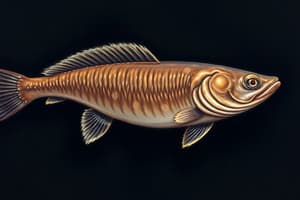Podcast
Questions and Answers
What is the phylum of Lampreys?
What is the phylum of Lampreys?
- Chordata (correct)
- Annelida
- Mollusca
- Arthropoda
What is the subphylum of Lampreys?
What is the subphylum of Lampreys?
- Invertebrata
- Cephalochordata
- Urochordata
- Vertebrata (correct)
What is the class of Lampreys?
What is the class of Lampreys?
- Amphibia
- Petromyzontida (correct)
- Actinopterygii
- Chondrichthyes
Identify seven characteristics of Lampreys' external anatomy.
Identify seven characteristics of Lampreys' external anatomy.
What kind of skeletal system does the Lamprey possess?
What kind of skeletal system does the Lamprey possess?
What kind of sex does the Lamprey have?
What kind of sex does the Lamprey have?
What kind of water habitats do Lampreys inhabit?
What kind of water habitats do Lampreys inhabit?
What kind of brain does a Lamprey have?
What kind of brain does a Lamprey have?
What function does the olfactory sac (nostril) serve?
What function does the olfactory sac (nostril) serve?
What is located right above the brain in a Lamprey and what function does it serve?
What is located right above the brain in a Lamprey and what function does it serve?
What is the role of the lateral line system in Lampreys?
What is the role of the lateral line system in Lampreys?
Describe the mouth of a Lamprey.
Describe the mouth of a Lamprey.
The lateral line system is a sensing ability that is termed ___?
The lateral line system is a sensing ability that is termed ___?
What is the definition of the pineal gland?
What is the definition of the pineal gland?
Flashcards are hidden until you start studying
Study Notes
Lamprey Overview
- Lampreys belong to the Phylum Chordata, indicating they possess a notochord at some stage in their life cycle.
- They fall under the Subphylum Vertebrata, signifying the presence of a complex nervous system and a cartilaginous skeleton.
Classification
- Class Petromyzontida includes all lamprey species, known for their distinct lifecycle and anatomical features.
External Anatomy Characteristics
- Pineal eye: A light-sensitive structure aiding in light detection.
- Presence of paired eyes and nostrils, crucial for sensory perception.
- Lateral line system: A series of sensory pores along the side of the body to sense vibrations and water flow.
- Buccal papillae: Small, sensory projections within their circular mouth that aid in feeding.
- External gills facilitate respiration within aquatic environments.
- Cloacal aperture serves as an exit for excretory products and reproductive materials.
Skeletal and Reproductive System
- Lampreys possess a cartilaginous skeleton supported by rudimentary vertebrae, retaining the notochord as the main axial structure even in adulthood.
- They are dioecious, meaning individuals are distinct male or female, supporting sexual reproduction.
Habitat and Behavior
- Inhabit freshwater lakes and oceans, demonstrating anadromous behavior by migrating to freshwater to reproduce, returning to streams or rivers.
Neurological Structure
- Lampreys exhibit a tripartite brain consisting of forebrain, midbrain, and hindbrain, managing sensory information and reflexes.
- The olfactory sac serves the crucial role of detecting chemicals in the water, essential for navigation and hunting.
Specialized Functions
- The pineal gland is a photosensitive organ that helps regulate biological rhythms in response to light changes, affecting behavior linked to day-night cycles.
- The lateral line system is responsible for mechanoreception, allowing detection of movement in water, which is vital for survival.
Oral Adaptations
- The lamprey's subterminal mouth is adapted for a parasitic lifestyle, featuring keratinized teeth for attachment and an abrasive tongue for feeding.
Studying That Suits You
Use AI to generate personalized quizzes and flashcards to suit your learning preferences.



